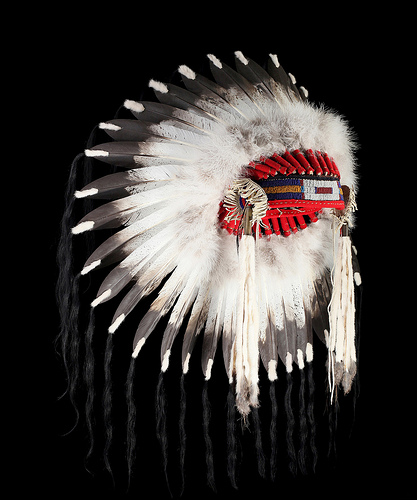A non-Native wearing a headdress because it “looks cool” is anything but respectful
Whether it’s a fashion designer feeling “inspired” by Native culture or a celebrity slapping on some war paint and feathers, it seems like the practice of misappropriating Indigenous cultures is growing across a vast majority of industries.

The latest culprit of the ongoing headdress-wearing hipster epidemic is Christina Fallin, the daughter of Oklahoma’s governor.
Last week, Fallin joined the likes of Karlie Kloss, Khloe Kardashian, Lana Del Rey, Gwen Stefani, Russell Brand, Harry Styles, and many other celebrities who donned a feather headdress and posted a picture of it to their social media accounts.
In a statement Fallin released after removing the picture from both Facebook and Instagram, she defended her actions and asked critics to “please forgive us if we innocently adorn ourselves with your beautiful things. We do so with the utmost respect.”
Appropriation, or the act of adopting or representing certain elements of another culture, happens everywhere. Unfortunately, there is a greater amount of ignorance among Canadians and Americans when it comes to problems with misappropriation involving Indigenous cultures.
However, as Native Appropriations blogger, Adrienne Keene, pointed out, what makes Fallin’s actions different from most is that it does not stem from pure ignorance. She blatantly labeled her post “Appropriate Culturation” and is therefore well aware of the concept of cultural appropriation, and knew it would be controversial. There is absolutely nothing respectful about that.
In a nutshell, all that her “apology” demonstrated was white privilege, a colonial sense of entitlement and an example of the oppression that Indigenous people continue to face today. If Indigenous people are expressing how they are offended by these types of actions and stereotyped imagery, then accept that, apologize, and don’t repeat similar actions. Do not tell us that you know better about what is and isn’t offensive to us.
Furthermore, our anger is far more than an oversight in cultural sensitivity. In her statement, Fallin mentions how she is “eternally grateful” for coming into contact with “Native American culture” growing up in Oklahoma. Which element of Native American culture does she mean?
There is no universal “Native American culture.” In Canada alone, we have over 50 distinct nations and over 360 First Nations communities, each with its own unique language, culture and traditions. The stereotypical feathered headdress or war bonnet typically worn by various Plains nations is not a staple in every nation’s regalia. There isn’t a single garment or item that can adequately represent Indigenous identity as a whole.
Fallin referred to a headdress as being a beautiful thing. It is okay to find our things aesthetically pleasing, because they are. However, admiration is not an excusable justification for wearing an item that is normally restricted to a specific culture.
If non-Natives admire a culture and want to show respect, learn about that culture. If non-Natives love Native fashion, spare a social media uproar by showing support for Indigenous designers by purchasing authentic Native swag rather than buying cheap knock-offs from stores like Forever 21.
While something like fashion may seem frivolous to many, wearing a headdress just because it looks cool is not only disrespectful to the nations that do wear headdresses for ceremonial purposes, but it also contributes to a fictionalized “pan-Indian” view of all Indigenous cultures. This undermines the diversity of all Indigenous people in Canada and the U.S.. All our distinct nations become a one-dimensional and fictionalized representation that is rooted in colonial ideology, without our consultation.
Not only is it offensive and hurtful, but has dangerous implications for our identities and an understanding by Canadians of who we are, the social, political and economic issues that we face, how we are treated by the government and society and, most importantly, ourselves.



